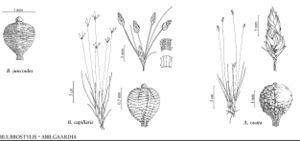Difference between revisions of "Bulbostylis juncoides"
Anales Mus. Hist. Nat. Montevideo, ser. 2, 3: 187. 1931.
FNA>Volume Importer |
FNA>Volume Importer |
(No difference)
| |
Revision as of 19:07, 24 September 2019
Herbs, perennial, densely cespitose. Culms 10–30(–40) cm, bases hard, swollen. Leaves ¼–1/2 length of scapes; sheaths brown to stramineous, abaxially glabrous or hirtellous; blades spreading to erect, filiform, wiry, less than 1 mm wide, involute, margins and adaxial surface glabrous to hispidulous or scabrid. Inflorescences terminal, mostly in compound, compact or diffuse, involucrate anthelae; scapes ascending to erect, wiry, 1 mm thick, coarsely ribbed, ribs glabrous or hispidulous to scabrid; proximal bladed involucral bract exceeding or exceeded by inflorescence. Spikelets red-brown to chestnut-brown, lanceoloid to cylindric, 4–6 mm, mostly longer than broad; fertile scales ovate, curvate-keeled, 2–2.5 mm, apex acute, glabrous or papillose-puberulent, midrib excurrent as mucro or mucronula. Flowers: stamens 3; anthers linear, 1–2 mm. Achenes gray to yellow-brown or dark brown, trigonous-obovoid, 1–1.2(–1.5) mm, faces rugulose, papillate; tubercle a globose button. 2n = 60.
Phenology: Fruiting all year.
Habitat: Savanna, prairie, steppes, basic and acidic rock outcrops, mostly higher elevations
Elevation: 100–3000 m
Distribution

Ariz., N.Mex., Tex., Mexico, West Indies, Central America, South America.
Discussion
Bulbostylis juncoides is unquestionably the most polymorphic species of its complex in Bulbostylis and with a potential synonymy more elaborate than given here.
Selected References
None.
